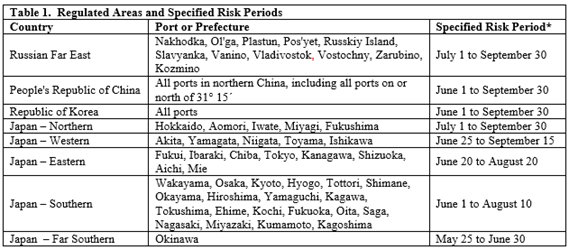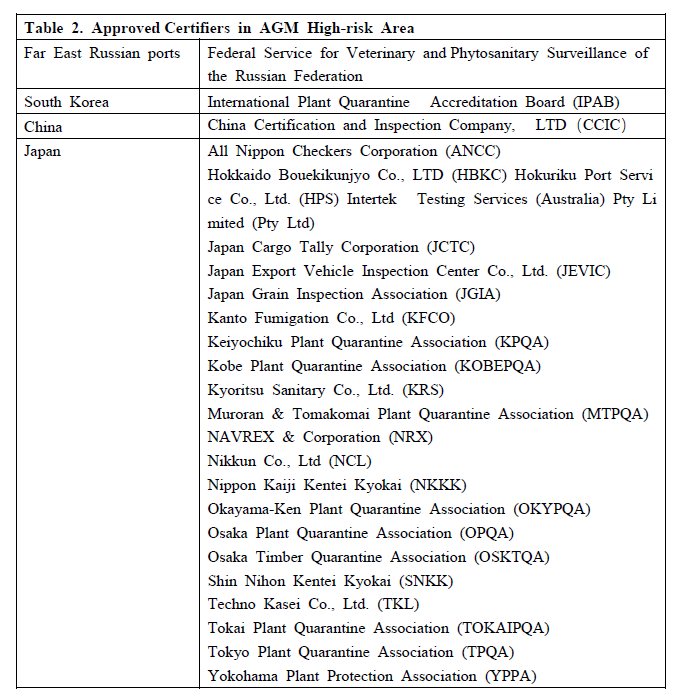LP 09/2019 Inspections on Asian Gypsy Moth in North American Ports
Asian Gipsy Moth (AGM) is a pest that feed on over 500 plant species with established populations in Far East Russia, Japan, China, South Korea, North Korea and Mongolia. If carried on vessels to North America, AGM would have significant negative impacts on local forestry and environment, not to mention that AGM female adults are capable of flying.
Although both the U.S. and Canada have been committed to reduce AGM risk, a very high number of moths was observed in many regulated ports during the 2018 AGM flight period. A joint notice was recently issued by the United States Department of Agriculture (USDA) and Canadian Food Inspection Agency (CFIA) to inform the industry of strengthened inspections at North American ports in 2019 flight season.
I. Required actions
For vessels that have called on areas regulated for AGM (see Table 1) during the specified periods in the last 24 months, the following measures are required:
1. Vessels must be inspected and must obtain pre-departure certification from a recognized certification body (see Table 2). A copy of the certificate, stating that the vessel is free of AGM life stages, must be forwarded to U.S or Canadian agents such as CBP (U.S. Customs and Border Protection) and CFIA. The certificate must be issued from at least the last port of call in a regulated area that was visited during the specific risk period.
2. Vessels must arrive in North American ports free from AGM.
3. Vessels must provide two-year port of call data, at least 96 hours prior to arrival in a North American port, to the Canadian or U.S. agent. The agent is to ensure that this information is provided to U.S. and Canadian officials.
In addition, due to sovereign regulations and policies, there are differences in port of-entry processes between the two countries. An inspection in the U.S. ports does not exempt the vessel from another inspection in Canadian ports, and vice versa. It’s hence advisable to conduct vessel self-checking, keep in contact with local port authorities and submit necessary certifications as required.


II. AGM life stages
According to USDA APHIS, the AGM matures through four life stages: egg, larva, pupae, and moth.
Egg: AGM are attracted to light; therefore, eggs are frequently laid near light sources. Egg masses are covered with yellowish to tan hairs (appearing fuzzy) but can bleach out to near white after prolonged exposure to direct sunlight.
Larva: Older instars have distinctive markings on the head capsule and are gray with five pairs of raised blue to blackish spots and six pairs of raised red to brownish-red spots along their back.
Pupae: Pupae are dark-brown reddish, fusiform, about 1/4 inch long and covered with yellowish fuzz.
Moth: Adult Asian gypsy moth (AGM) males have grayish-brown wings with black markings and a 1½- to 2-inch (3.8-5 cm) wingspan. Adult female AGM are heavy-bodied and can have a wingspan of 3½ inches (8.9 cm) or more. Female wings are white with black markings; however, they rarely exhibit color morphs and appear almost black, can fly distances up to 25 miles.
III. Risk factors considered by CBP & CFIA
Vessels will be considered of high risks if:
l called on high-risk ports during designated AGM high-risk periods during the current or previous year;
l reports or observations that indicate AGM might be present;
l not receiving a predeparture AGM inspection during the most recent voyage to a high-risk area
l not having an inspection certificate after being in a high-risk area on the most recent voyage.
IV. Procedures for ships with AGM risks
Non-certified vessels will receive an AGM inspection at all U.S./Canadian ports on each voyage when itinerary suggests AGM risks.
Even if the vessel is certified, an AGM inspection will be conducted if CBP/CFIA determines it’s necessary.
If AGM is suspected on a vessel, re-inspections will occur at subsequent ports. If AGM is detected and/or confirmed, the suspects will be collected and sent for identification. The officer will then determine if it’s necessary for a re-inspection or an order to execute departure, based on the level of infestation, unless the ship is unseaworthy or in the middle of bunkering operations.
Ships may request reentry to U.S./Canadian ports when they give assurances that all egg masses are removed or disposed of properly. A re-inspection will be arranged in waters or anchorages out of the way prior to the reentry. Any subsequent suspect AGM found during re-inspection will result in additional pest prevention action. These actions will result in costly delays and further detection of potential AGM presence may lead to denying entry into North American ports.
Ships entering Guam, Hawaii, Puerto Rico and the U.S. Virgin Islands will not be excluded but may be inspected for AGM if the ship’s schedule includes subsequent continental U.S. ports of call.
V. CBP & CFIA AGM Inspection
If CBP & CFIA determine that an AGM Inspection is needed, the officer will request to board the vessel. The officer will carry out a complete search with tools including flashlights, binoculars and reflective mirrors. Officers will look:
l in sheltered locations,
l in crevices and cavities,
l under tarps,
l behind walls and doors,
l around light fixtures,
l underneath the hold rims,
l and anywhere else that AGM might lay eggs.
VI. Advice to Members
With the safety of port operation guaranteed, it’s advisable to minimize onboard lighting while calling at regulated areas during the AGM flight season. Doors to the accommodation area should be kept closed and curtains in the rooms should be drawn. Mariners are encouraged not to use lights or to use only the bed light when in room.
Masters should contact the company and the agent for an early predeparture inspection by a recognized certifier in order not to hold up the schedule.
A designated mariner should be appointed to conduct the predeparture inspection with the port officer for his safety and for a thorough self-check.
Issuance of a certificate does not mean that the vessel is free of AGM risks and the master should always include AGM inspections as one of the primary tasks.
Apart from a structural inspection, a thorough check on the cargo should also be carried out as per an established AGM checklist. The deck and the bottom of containers are difficult areas to spot hidden egg masses.
Do not remove egg masses in the corner with high pressure water guns and scrape them off instead if there are any. Eggs may be destroyed by incineration and disposing them off into trash cans or water will not kill them.
The vessel should be clean and tidy. Obstructions such as lubricating oil drums, dunnage, angle iron and ladders should be cleared off for the convenience of AGM inspection officers at North American ports.
CBP & CFIA officers would normally board vessels in the early morning or the late afternoon during which time the AGM, if there are any, will be drawn to the lights on the deck. Also, it won’t be too dark for the officers to inspect the ship with binoculars and mirrors. Reasonable arrangement should be made by the master for the inspection to be efficiently carried out.
It should be noted that different from the ship’s sanitation certificate, the term of validity of the AGM-free certificate is not definite. If a vessel has obtained a certificate for calling on a high-risk port in its previous voyage and has gone through the CBP/CFIA inspection, a re-application for certificates will still be necessary for calling on another high-risk port.
In the circumstances where a ship that has visited high-risk areas in the last 24 months did not obtain a certificate as it was not planning on heading to the U.S./Canada, the master is advised to obtain a certificate if it later plans on entering U.S./Canadian ports.
For further information, please contact your manager at the Club.
